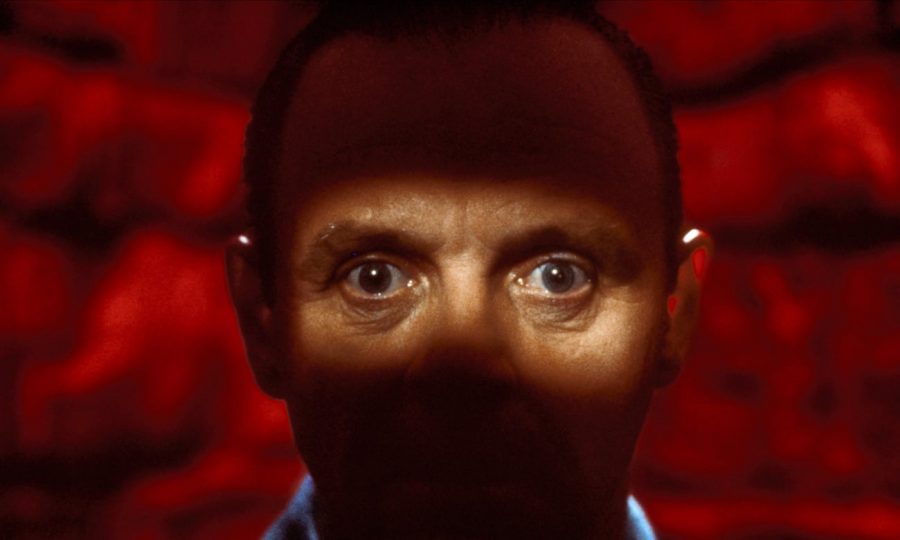Quid Pro Quo, Clarice: Horrorfest–The Silence of the Lambs
December 15, 2019
There are movies that draw fear from bloody scenes of destruction. There are some that draw fear from supernatural monsters with rows of jagged teeth and a taste for the fears of children. And then there are those that invoke pure dread by digging into the psyche of the viewer, pulling out their darkest secrets, and warping them into a perfect amalgamation of absolute terror.
The Silence of the Lambs is a flawless example of such a film, which can be credited to how the movie addresses themes of psychological decline, murder, and cannibalism. Though these topics are undoubtedly grotesque, the movie thrills in the way it subtly warps one’s sense of reality and fear.
Released on Valentine’s Day, 1991, The Silence of the Lambs quickly became the fifth highest grossing film of 1991. It was critically acclaimed upon its release, and became the third movie ever to win Academy awards in all 5 top categories: Best Picture, Best Director, Best Actor, Best Actress, and Best Adapted Screenplay. Eventually, in 2011, the film was selected to be preserved in the National Film Registry due to its “cultural historical or aesthetic” significance. The film stars Jodie Foster and Anthony Hopkins. Both actors and their cinematic prose contributed to the success of the movie.
The movie is a cinematic adaptation of Thomas Harris’s 1988 novel and was directed by Jonathan Demme. It required actors to reach past their psychological barriers in order to portray the appalling personas they were cast as.
When asked by The Graham Norton Show in 2016 if she could distinguish between Hopkins himself and Hannibal Lecter, Jodie Foster (Clarice Starling) responded, “Nope, never spoke to him. He was scary!”
“Lecter is a manipulator and has a way of using language to keep people at bay… you wanted to see that Shakespearean monster. That’s why we jumped the pond,” Foster said to the British Film Institute in 2017, in regards to how Hopkins played his character.
According to my ranking scale, The Silence of the Lambs scores* a reputable 64/80 overall.
Color Scheme
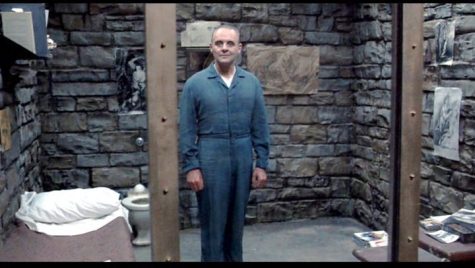
The muted tones of every scene, including the scene where Lecter first meets Agent Starling, give forewarning to the shocking red of blood that is soon to occur.
Set right outside of Pittsburgh, The Silence of the Lambs features a muted color palette that, while a bit dull, ultimately draws attention to the starkness of the crimson blood that makes an appearance in so many scenes. The muted blues and grays of each scene also make the terror of the crimes committed more apparent, because they are occurring in the mundane suburbs of Pennsylvania. The Silence of the Lambs definitely deserves a solid 7 for Color Scheme as a result.
Costuming
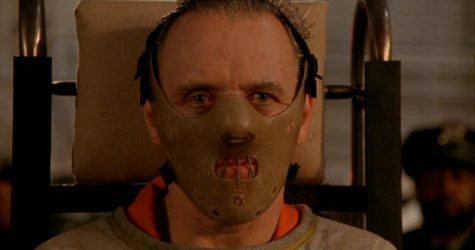
Hannibal Lecter, wearing his muzzle. This image of Lecter would become iconic in pop culture following 1991.
Costuming for The Silence of the Lambs earned a very respectable 6, but it wasn’t a central element to the movie. The two standout examples of costuming in my opinion were the scenes where Hannibal was bound by a human muzzle, and when Buffalo Bill experimented with a visually-uncomfortable mockery of transvestism in his basement. These scenes served to dehumanize both of these characters, and to really show how far they had strayed from acceptability in society.
Special Effects
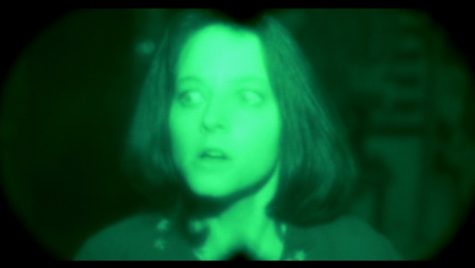
Buffalo Bill peers at Agent Starling through night vision goggles, which proves the detail put into special effects by filmmakers.
Starkly shocking and surprisingly realistic, the special effects in The Silence of the Lambs most definitely deserves a 9. Similar to the Gore category below, the special effects included in the movie are terribly realistic. Each scene involving special effects work, such as the rampart-esque display of the corpse in the city hall after Hannibal Lecter escapes, opens the eyes and draws breath from the lungs.
Gore
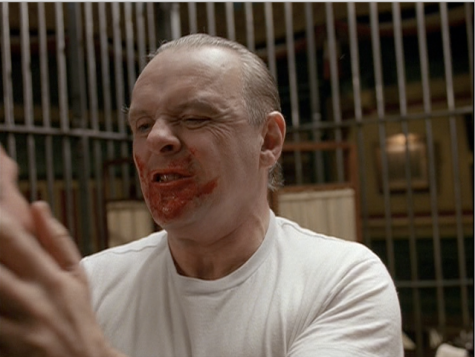
Lecter claims another victim. Although we don’t directly see the killing, the gory splash of blood upon his pale white face indicates the killing.
There’s a fine line between gore being tastefully shocking, and gore being crude in the way it stuns the audience. The Silence of the Lambs tends to toe that line rather frequently, as there are oft-featured scenes of blunt mutilation that could put a wince on the face of even the most seasoned horror fan. However, these scenes can also contribute to the development of of fear and paranoia in the movie, and the gore included is so grotesque that it’s easy to forget that the carnage isn’t real. Therefore, this film scored itself a 9 in regards to gore.
Date and Time Period
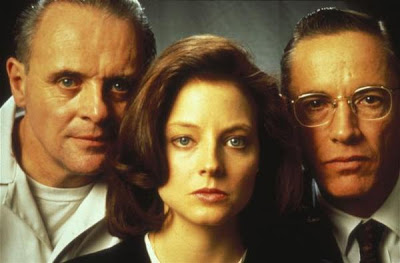
The ’90s shone through in music choice and in wardrobe, but lacked prevalence in other areas of the film.
The Date and Time Period element of The Silence of the Lambs wasn’t very significant or impactful to the story, so it earns a 5 in this category. The movie is set in the early 1990s, but the political or social context of the time wasn’t really relevant in the story. I think that the film could’ve occurred in a different decade and still have had the same effect on film viewers.
Soundtrack

The soundtrack of The Silence of the Lambs included many symphonic songs, but also included songs by bands such as Tom Petty and the Heartbreakers.
All of the background/ambient music in The Silence of the Lambs was performed by the Munich Symphony, but songs by bands such as Tom Petty and the Heartbreakers, Q Lazzarus, and Savage Republic contemporized the film. These songs brought even more attention to the fact that the killings in the movie occured in a typical, modern community. This leads me to rank The Silence of the Lambs an 8.
The Monster
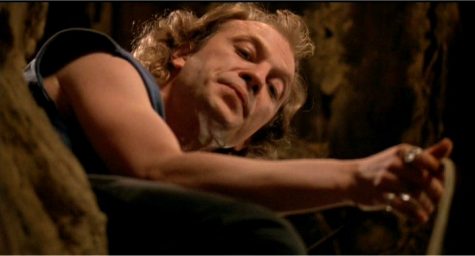
Buffalo Bill stares down his newest victim, who has been thrown in a deep underground well.
“The Monster” is nearly always a symbol or contortion of reality in horror films, and in The Silence of the Lambs this common thread remains true. Clarice Starling, the young FBI agent and main protagonist in the movie, is assigned to catch Buffalo Bill, a serial killer out for young women. In a nonanalytical sense, he is the obvious monster of the film. However, a second (and far more multifaceted) villain is put into play–Hannibal Lecter. Though he is clinically insane, brilliant beyond anything else, and a feared cannibal, he ends up helping Clarice in her journey to capture Buffalo Bill. Whether he is a true “monster” or not is a matter of subjectivity, left up to the viewer to decide. However, Hannibal’s psychological analyses of characters throughout the film bring another “monster” to center stage–the abysses of one’s own mind. A scoring of 10 is most appropriate in this case.
Suspense Factor
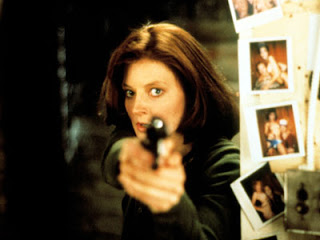
As Clarice Starling waits for Buffalo Bill, the audience grows tense with worry for the agent’s life.
Suspense Factor is perhaps the strongest facet of The Silence of the Lambs unarguably, earning a perfect 10. Around every twist and turn of the movie, another element of worry and fear is added as music tempo picks up, faces grow more gaunt, and more deaths occur. One of the final scenes of the movie is the zenith of all the pent-up suspense, as you watch Clarice Starling whirl around in the dark with a loaded gun in her trembling hands, viewed through the night vision goggles of Buffalo Bill himself. You can feel your heart beat in frantic unison with Clarice’s, and when she shoots, your heart freezes in your chest. This is a sign of a remarkably made horror film–you become the character themselves.
The Silence of the Lambs is far more than just a horror movie–it pries into the deepest feelings and thoughts of people and brings them together in a film. Though it lacks anything supernatural or undead, it shocks and frightens with the fact that every atrocity in the film is committed by a human…a person just the same as you or me.
Dr. Hannibal Lecter: Why do you think he removes their skins, Agent Starling? Enthrall me with your acumen.
Clarice Starling: It excites him. Most serial killers keep some sort of trophies from their victims.
Dr. Hannibal Lecter: I didn’t.
Clarice Starling: No. No, you ate yours.
*In case you need a refresher, each movie is rated in 8 categories–Color Scheme, Costuming, Special Effects, Gore, Date & Time Period, Soundtrack, “The Monster” and Suspense Factor. These scores, which are out of 10, are added together to create an overall ranking, the highest being 80.


